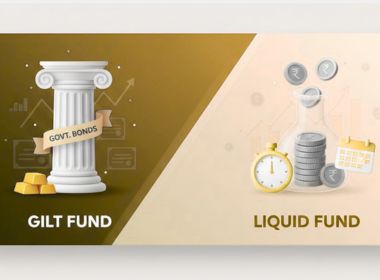Search Suggestions
- Gold Loan
- Money Transfer
- Mutual Funds

Difference Between Gold ETFs and Gold Bonds
Gold is one of the most valuable assets that offers higher returns. Indians have an emotional attachment to gold due to its deep cultural significance. Purchasing gold during occasions like Diwali is seen as a ritual. Nonetheless, it is the safest form of investment.
Table of Content
- What is a Gold ETF?
- Features and Benefits of Investing in Gold ETF
- What are Sovereign Gold Bonds (SGB)?
- Features and Benefits of Investing in SGB
The rate of gold in India fluctuates daily, with inflation being one of the most significant factors that impact the gold rate in India. Other factors like global economic instability, global development, and a rise in the dollar prices against currencies of other nations influence the rate of gold.
It is only recently that we have been introduced to the concept of digital gold. Investing in digital gold offers benefits such as eliminating the need for storage space, can be used as collateral and is easy to gift to others.
With a rise in the prices of physical gold, people are choosing gold investments in digital forms like Gold ETFs (Exchange Traded Funds) and Sovereign Gold Bonds (SGB). Both of these options allow investing in gold without holding physical gold. However, the features, benefits, and risks that are involved differ from each other. This blog highlights the differences so that the readers can make well-informed decisions when it comes to gold investment.
What is a Gold ETF?
It is a type of mutual fund investment issued by the Asset Management Companies or Mutual Fund houses that are registered with the SEBI (Securities and Exchange Board of India). These funds track the price of gold without owning the metal physically. Gold ETFs are listed and traded on stock exchanges just like shares. With an existing demat account and trading account, investors can buy or sell Gold ETFs. This makes investments in Gold ETFs convenient and cost-effective. One unit of Gold ETF usually represents 1 gram of 24-carat gold. They are highly liquid, which makes it easy for investors to buy and sell without bearing any loss.
Features and Benefits of Investing in Gold ETF
- The price of each unit of the Gold ETFs represents the actual price of physical gold in the market. This makes the pricing factor more transparent to the investors.
- Since Gold ETFs are traded on stock exchanges, it makes it very easy for investors to buy and sell Gold ETFs.
- Investments in Gold ETFs are ideal for short-term traders and investors who prefer flexibility and liquidity.
- There is no lock-in period on Gold ETFs. They are open-ended mutual fund schemes that give investors the benefit of whether to remain invested or not, of their own free will.
- You can invest in Gold ETFs through a systematic investment plan (SIP) and can use them as collateral for availing loans.
- Gold ETFs do not offer interest income. Returns or profits are based on the prices of the gold in the market.
Suggested Read: How to Invest in Gold: Smart Ways to Secure Your Wealth
What are Sovereign Gold Bonds (SGB)?
Sovereign Gold Bonds are a type of government-backed securities issued by the Reserve Bank of India on behalf of the Indian government. Denominated in grams of gold, SGBs are a kind of substitute and a superior alternative to owning physical gold.
Depending on the notification by the government of India, the minimum investment is one gram, with a maximum limit of subscription of 4 kg for individuals, 4 kg for Hindu Undivided Family (HUF), and 20 kg for trusts and similar entities.
SGBs are sold through offices or branches of nationalised banks, scheduled private banks, scheduled foreign banks, designated post offices, and the Stock Holding Corporation of India Ltd. Though investing in SGB is synonymous with owning gold. However, not in physical form, but it allows investors to earn interest on it.
Features and Benefits of Investing in SGB
- Besides offering capital appreciation when gold prices soar, SGB additionally offers a fixed interest rate of 2.50% per annum on the initial investment amount.
- Investments in SGB are a safe option for long-term traders. However, they have a minimum lock-in period of 5 years. This makes the liquidity lower compared to Gold ETFs.
- SGBs offer tax benefits such as exemption from capital gains tax when held till maturity.
- Unlike Gold ETFs, which are subject to market risks. SGBs ensure safety as they are backed by the Reserve Bank of India on behalf of the government.
- SGBs can be used as collateral for availing loans from banks and NBFCs. The Loan-to-Value ratio will be the same as applicable to an ordinary gold loan.
- The cost associated with SGBs is more transparent as there are no recurring costs of ownership.
SGB is a government scheme that allows individuals, trusts and business entities to invest in gold without bearing much risk. Muthoot Finance offers a very easy and convenient option for investors to invest in Gold ETFs.
- Avail gold loan
- Calculate Gold Loan
- Check Gold rate today
- Gold Loan Eligibility
- Interest Rate
- Gold Loan Scheme
- Custom Offers
CATEGORIES
OUR SERVICES
-

Credit Score
-

Gold Loan
-

Personal Loan
-

Cibil Score
-

Vehicle Loan
-

Small Business Loan
-

Money Transfer
-

Insurance
-

Mutual Funds
-

SME Loan
-

Corporate Loan
-

NCD
-

PAN Card
-

NPS
-

Custom Offers
-

Digital & Cashless
-

Milligram Rewards
-

Bank Mapping
-

Housing Finance
-

#Big Business Loan
-

#Gold Loan Mela
-

#Kholiye Khushiyon Ki Tijori
-

#Gold Loan At Home
-

#Sunherisoch
RECENT POSTS

Gilt Fund vs Liquid Fund: Full Form, Meaning & SIP Guide
Know More
XIRR in Mutual Funds & SIP: Full Form, Meaning, Formula and How to Calculate
Know More
7 Key Factors to Consider Before Taking an SME Loan
Know More
Difference Between Black Gold and Gold: Everything You Need to Know
Know More
NPS vs EPF: Everything You Need to Know About Retirement Savings
Know More
What is a Credit History? Impact on Credit Score and Credit Report
Know More
Loan Closure Vs. Loan Settlement: Meaning, Benefits, and CIBIL Score Impact
Know More
Is Silver the New Gold? A Look at 2025 Price Trends
Know More
What Are the Various Types of Equity Funds and How They Work?
Know More
Why Are Gold Loans Becoming the Most Preferred Financial Option in 2025?
Know MoreFIN SHORTS

What Are Co-Pay and Deductibles in Insurance Policies?
Know More
Should You Take a Loan Against Your Mutual Fund or SIP?
Know More
Top 5 Best Mid-Cap Mutual Funds to Watch in 2026
Know More
Are Personal Loans Right for Retirees? Key Points to Consider
Know More
What Happens to a Personal Loan After the Borrower Dies?
Know More
Best Loan Choices for Credit Scores of 580 and Below
Know More
7 Reasons Why a Gold Loan Is the Best Option for Small Businesses
Know More
10 Reasons Why People in India Prefer Physical Gold
Know More
Real Estate vs Gold: Which Is a Better Investment in India?
Know More
10 Common Mistakes That Make Investors Lose Money in Mutual Funds
Know More
10 Reasons Why Gold Has So Much Appeal in Uncertain Times
Know More
7 Ways Settling Debt Can Impact Your CIBIL Score
Know More- South +91 99469 01212
- North 1800 313 1212


